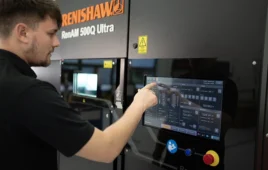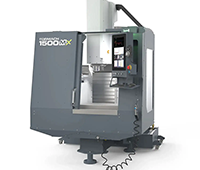The Echo prosthetic leg is specifically designed to improves a dog’s mobility and balance, giving them a second chance at life while reducing pressure on his body and avoiding potential spinal issues. Model Solution assisted Shubham Harish, a student at the College for Creative Studies, to develop the design for the canine prosthetic leg. Model Solution’s design team worked to verify the design for manufacturing and select more suitable materials and manufacturing processes for use during the prototyping phase. At the end of the process, Model Solution developed a high-quality appearance model of the Echo prosthetic leg that was showcased at the 2017 IDSA conference in Atlanta.
avoiding potential spinal issues. Model Solution assisted Shubham Harish, a student at the College for Creative Studies, to develop the design for the canine prosthetic leg. Model Solution’s design team worked to verify the design for manufacturing and select more suitable materials and manufacturing processes for use during the prototyping phase. At the end of the process, Model Solution developed a high-quality appearance model of the Echo prosthetic leg that was showcased at the 2017 IDSA conference in Atlanta.
Form, fit and function is vital to determine whether a prosthetic would be successful for a specific canine. Considerations of comfort, natural movement, communication between the body and the new limb, the need for adjustments and proper fit, and the use of breathable materials have all been met by the Echo dog prosthetic limb, which is able to return confidence and happiness to both the dog and its owner. The Echo utilizes a ReMotion Knee joint that mimics the function of the dog’s knee by creating the necessary back and forth movement of the limb. A vacuum suction socket and one-way liner with multiple small magnetic points allows a tight and comfortable fit. The attraction between points when the dog stump is in the vicinity of the socket helps with the initial fit, and suction helps the stump go all the way in. Pelite, which is a lightweight material and soft-to-the-touch, was used for cushioning the socket while urethane was used for padding the one-way liner to reduce friction between the skin and socket.
The process for building the prototype model for the Echo dog prosthetic included structural design work, CNC machining, wet-sanding, plating, painting, screen printing and final assembly. The Echo was built from ABS plastic, pelite sponge foam, urethane, aluminum and brass.
To simplify and improve the appearance of applied finishes, Model Solution modified the design to utilize CNC machined ABS plastic parts instead of 3D printing and selective laser sintering (SLS) carbon-fiber reinforced nylon. Also, Model Solution was concerned about rubber shrinkage for certain parts during the manufacturing process, so those parts were made out of hard plastic. In order to provide the rubber-like feel that the designer wanted, they were then painted with soft-touch paint.
Model Solution is also working with other consumer electronics companies to produce prototypes like the Echo prosthetic limb for the 2018 Consumer Electronics Show in January.
To learn more about the Echo prosthetic limb, go to https://www.model-solution.com
Model Solution
www.model-situation.com
Filed Under: MANUFACTURING





I am interested in your prosthetic limb for dogs. Today I had to make the difficult decision to have my best freind’s front leg removed due to an injury. I want to know what is involved on my side for you to produce an artificial limb for him please. I have worked with many wet materials and carbon fiber. So if a mould is needed I am capable of making one.
Please advise on price and what you need from me.